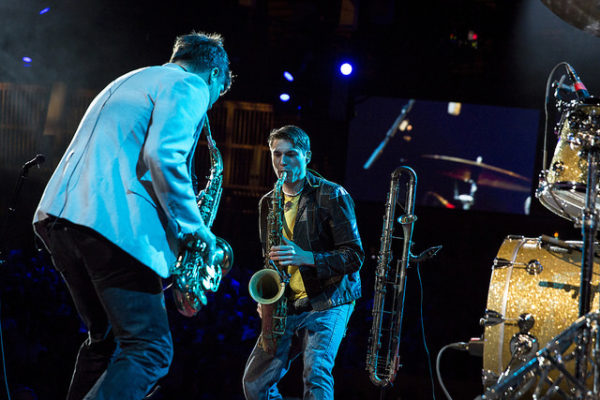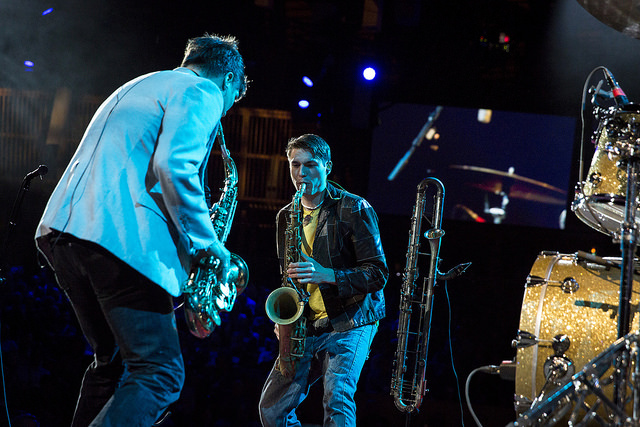
In the wake of Moon Hooch’s new EP “The Joshua Tree,” I chatted with founding member Mike Wilbur about his Brooklyn-based trio. From their roots busking in the subways of New York, they have since translated their urban performance efforts into three studio albums and, now, an EP.
Wilbur and his bandmates James Muschler and Wenzl McGowen met in The School of Jazz at The New School in New York. A stroke of fate placed them on the same floor, and from there they started busking, building chemistry and making money. After recording and mixing their self-titled debut in just 24 hours, Moon Hooch leaped from spontaneous street performance to planned gigs.
—
TSD: What’s the biggest difference between playing in a subway for random people and playing for people who came to see you in a show?
MH: Very different energy when people are not expecting to hear or even want to hear you blow your saxophone as loud as you possibly can. You know, it’s … a very different dynamic. Sometimes in the subway we pissed a lot of people off. We made a lot of people happy, too. But usually in shows everybody’s there: They want to hear it. They bought tickets. They know what they’re in for, or, at least they know what they’re getting in to. I’d say that’s the main difference. There are no cops coming up on stage harassing us. There are no homeless people hanging out with us, which is kind of a bummer. Homeless people in the subways are pretty chill, actually, for the most part. It’s a different scenario, man. Playing in the subway is a pretty weird reality. There’s constantly changing people in and out. The audience is changing all day long — the variety of reactions changes all day long. You can also really tap into what people like, what people want to hear, more like what the most people want to hear … not that we’ve necessarily figured that out, but we figured out what some people like.
—
Moon Hooch put their street performance to tape on their first record, even naming songs based off of the hand signals they would give each other before playing each song “so we didn’t have to stop because [we] were trying to have a dance party, play like a DJ would.” As they began to mature as artists and push past just playing tenor sax, baritone sax and drums, they started to experiment with different instruments and genres with varying degrees of success.
Moon Hooch is tough to define, even for its members. The scaffolding of their sound is jazz, evidenced by the members’ shared jazz school alma mater. Terms have flown around to try to encapsulate their unique sound. Their basis in jazz usually has critics filing them into the wide umbrella genre of nu jazz, which can range from Flying Lotus to Dave Douglas to King Krule. To try to pinpoint their sound for the critics, Moon Hooch members themselves insisted after their first album that they played “cave music,” that their sound and what it invoked within its listeners was something undeniably primal, like cave paintings that are simple in concept yet complex in execution.
The latter is definitely more accurate than nu jazz, but I was still not satisfied. To implore artists to define their sound is a clichéd, almost silly, convention of music criticism, akin to yelling at a Van Gogh demanding it tell you what brand of Impressionism it is. But Moon Hooch is different. They create a curious sound accompanied by instruments and songwriting techniques of different musical styles. With one of the sound’s creators before me, I asked Wilbur for an updated take on his own band’s work.
—
MH: I don’t really know how I’d describe it other than energy music. We’re just putting energy and almost invoking something deeper. At least that’s what we’re going for.
—
Moon Hooch is not a consequence of their sound but rather their intention. Whenever performing, be it at a festival or at an NPR Tiny Desk concert, they’re just putting out energy. What comes out is a medley of genres, a consequence of spending years spontaneously performing for strangers, subtly molding their sound to bring a smile and an urge to dance to subway-goers’ faces. Their work encompasses the hard-hitting jazz fusion of “Number 9” on their eponymous debut, the alternative rock-esque “Shot” on their 2016 album “Red Sky,” the heavy metal jazz of “Improv” on “The Joshua Tree” and the dubstep of the aptly-titled “Contra Dubstep” on “This Is Cave Music.”
While Wilbur clarifies that their recent work in “The Joshua Tree” and “Red Sky” is “our most rehearsed record[s],” he also believes that what “energizes [him] the most is improvising,” a key aspect to the energy of their sound. It’s a vicious cycle of vitality: In energizing their listeners, they energize themselves. The cycle continues until you press pause.
Moon Hooch is playing The Fillmore in San Francisco on Feb. 24.
Contact Dylan Grosz at [email protected].
